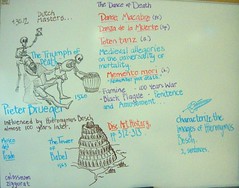
Magnet fine arts / Pieter Bruegel's The Triumph of Death and The Tower of Babel
Originally uploaded by trudeau
The most obvious influence on his art is the older Dutch master Hieronymus Bosch, particularly in Bruegel's early "demonological" paintings such as The Triumph of Death and Dulle Griet (Mad Meg).
The Triumph of Death shows a panorama of army of skeletons wreaking havoc across a blackened, desolate landscape. Fires burn in the distance, and the sea is littered with shipwrecks. A few leafless trees stud hills otherwise bare of vegetation; fish lie rotting on the shores of a corpse-choked pond. In this setting, legions of skeletons advance on the living, who either flee in terror or try in vain to fight back.
The painting shows aspects of everyday life in the mid-sixteenth century. Clothes are clearly depicted, as are pastimes such as playing cards and backgammon. It shows objects such as musical instruments, an early mechanical clock, scenes including a funeral service, and various methods of execution, including the breaking wheel, the gallows, and the headsman.
Bruegel's depiction of the architecture of the tower, with its numerous arches and other examples of Roman engineering, is deliberately reminiscent of the Roman Colosseum,[3] which Christians of the time saw as both a symbol of hubris and persecution.
The tower was seen as an example of pride punished.




No comments:
Post a Comment